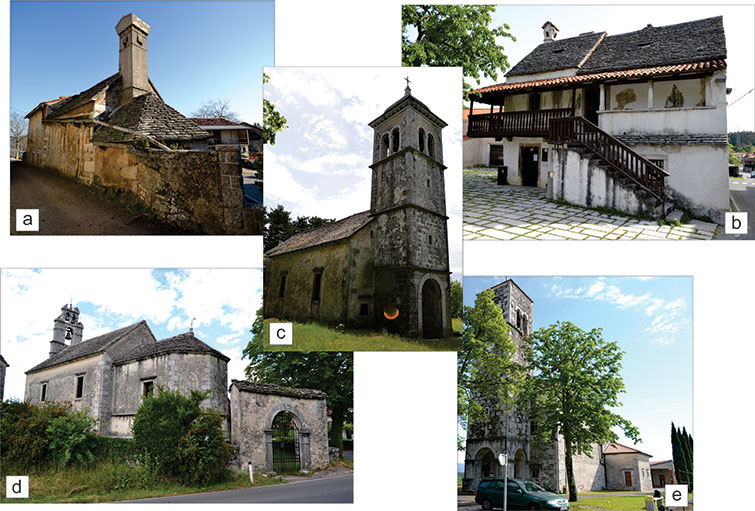Platy limestone – geologic definition and its use as a mineral commodity
Jernej Jež, Uroš Barudžija, Sara Biolchi, Stefano Devoto, Goran Glamuzina, Tvrtko Korbar
Five show-case objects selected in the RoofOfRock project area in Slovenia are situated in the Kras. Four objects are located in the southern part of the plateau: Divača, Gorenje pri Divači, Gura hill above Povir village and Šmarje pri Sežani, while th St. Elijah church is located in the village of Kopriva in the central part (Fig. 2.3). Two of them are typical karst farm houses, while three of them are churches (Fig. 2.5).

The roofs of the houses studied in Divača and Gorenje and church on Gura are mainly covered with limestone plates of Fractured Repen limestone. The stone originates from the Repen Formation extending in a narrow belt from Divača to Sežana. In this area three important abandoned quarries were recorded at the Gabričje and Griža (Tavčar) localities. These are potential source areas for relatively high-quality limestone plates. On the roofs of these three objects, only a few plates of platy limestone types from Sežana or Povir Formations were found. They were excavated in the close vicinity of the objects. On the other hand, limestone plates used on the roofs of churches in Šmarje and Kopriva originate from “genuine” Komen platy limestone successions (see Appendix 2.2). On the church in Šmarje, Komen limestone from the Povir Fm. was used for the roofing. It is exposed on a wider area of the Šmarje village. The church’s roof in Kopriva is covered with plates of Komen platy limestone from the Sežana Formation, which is exposed on a wider area between Kopriva, Skopo and Kosovelje villages, where also two smaller abandoned quarries were found.
Limestone blocks for all other external building elements were mainly made of Repen and Kopriva limestone types
Limestone blocks for all other external building elements were mainly made of Repen and Kopriva limestone types. Only some elements are of Lipica unito or Lipica fiorito types originating from the Lipica Formation. Repen and Kopriva types are one of the most high-quality natural stones in the Kras and due to their good quality are very suitable for external use. In the southern part of Kras Repen and Kopriva types were excavated in the Griža (Tavčar) and Boršt quarries. Around Sežana, these types can be found in the Lisična, Vitez and Doline quarries as well as in some smaller abandoned quarries (e.g. Lenivec 2, Bršljanovc). In the area of the Kopriva quarries, Rova, Kremenik, Zaboršt and Predole are present, where Repen and Kopriva limestone can be found.
Manufactured elements characterized by their standardized dimensions for some minor recent replacements on the studied objects mostly originate from the major active quarries of Lipica or Repen limestone (e.g. Lipica 1, Griža, Doline).
However, building limestone in the selected show-case objects in Slovenia mostly originates from local sources situated in the vicinity of the objects. This is typical for both platy limestone elements as well as other external architectural elements. The walls are mainly built from material from the immediate surroundings of the objects, while more important (manufactured) elements of larger dimensions (e.g. corner stones, window frames, door posts) originate from nearby quarries of high-quality natural stone.










